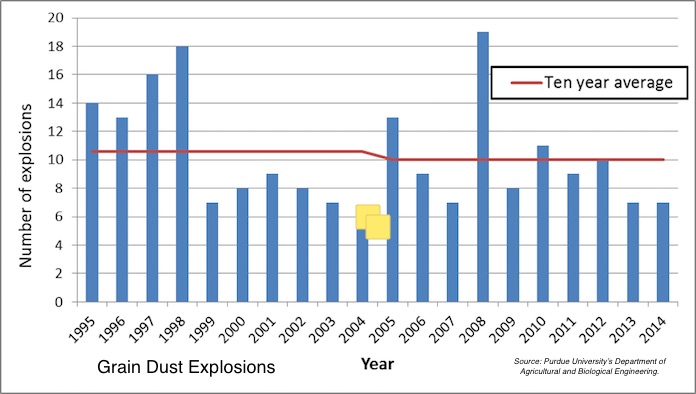The number of grain-dust explosions reported in the United States increased from five in 2016 to seven in 2017 but still remained under the 10-year average of 9.3, according to a new report by Purdue University’s Department of Agricultural and Biological Engineering. Six states reported grain-dust explosions in 2017 that resulted in a total of 12 injuries and five fatalities.

“Even with a 40 percent increase in the volume of grains handled and processed since the OSHA grain-handling standard was promulgated in 1988, the number of incidents has steadily declined over the past 10 years,” said Kingsly Ambrose, assistant professor of agricultural and biological engineering and lead author of the report. “Keeping the facility clean, training employees and contract workers, keeping equipment in good working condition by preventive maintenance and the use of dust explosion suppression systems and venting systems are good prevention practices.”
During 2017, Indiana, Iowa, Minnesota, Nebraska and Oregon each reported one grain-dust explosion and Wisconsin reported two. One injury was reported in Oregon, the other 11 injuries and all five fatalities occurred during a May 31 explosion at Didion Milling in Cambria, Wisconsin.
Didion Milling Explosion
Didion Milling, which processes corn and corn by-products for ethanol plants, was one of the largest employers in Cambria, a small community located about one hour northeast of Madison. Sixteen employees were inside the lab building when the blast occurred around 11 p.m., only two of them made it out safely. Pawel Tordoff, 21, Duelle Block, 27 and Robert Goodenow, 53, were killed in the explosion. Forty-six-year-old Angel Reyes died June 6 from injuries he sustained that night. Collin Vander Galien, 23, lost both of his legs when they were crushed by a rail car that landed on them after the explosion. Others who were wounded suffered third-degree burns and other explosion injuries.
OSHA Violations
Prior to the explosion, Didion had been cited by the U.S. Occupational Safety and Health Administration (OSHA) for safety violations, according to the agency’s records. Inspectors noted fall risks twice in 2014, a dust explosion risk in 2013, an amputation incident in 2012 and dust explosion risks twice in 2010.
In a report about the May 31, 2017, explosion, OSHA inspectors said they found 19 safety violations and determined that the blast was the likely result of the company’s failure prevent the accumulation of grain dust and properly maintain equipment. The agency proposed $1,837,861 in fines, some of which the company planned to protest.